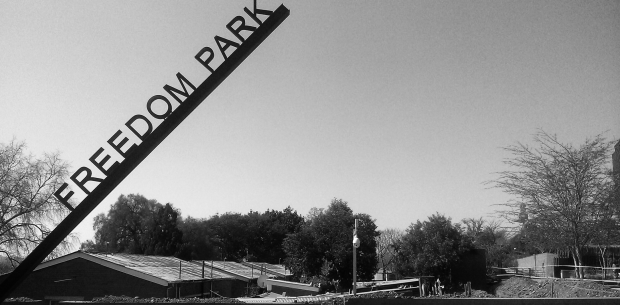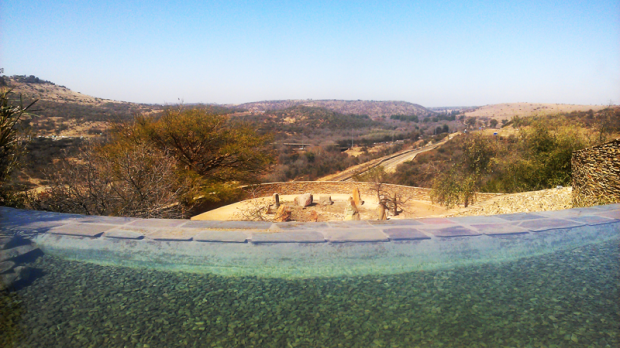
In the past two weeks I have been participating in the Institute for Justice and Reconciliation (IJR)’s Transitional Justice in Africa Fellowship. The programme brings practitioners, scholars and researchers from across Africa to South Africa for three weeks to engage, share and learn from the different transitional justice journeys taking place on the continent. This years’ programme features seven people from Uganda, Burundi, DRC, South Sudan and Zimbabwe.
The first week was memorable because we focused on memory!
The fellowship began with four days in Gauteng with visits to memorial sites such as the Voortrekker monument (built in the late 1930s to remember the first Afrikaaners that traveled inwards from the southern coast of Africa during what is known as ‘The Great Trek’). The Voortrekker monument is a large mausoleum-like stone structure that broods over the city of Pretoria and, interestingly, another memorialisation site known as Freedom Park. More about that later.
On the inside walls of the monument is a 360 degree marble mural sculpture depicting the experiences of the Voorktrekkers as they made their travels. In the center of one wall is the depiction of Voortrekker leader Piet Retief being betrayed and murdered by Zulu leader, Dingane, after signing a peace agreement. The events are theatrically portrayed and speak to the monument’s martyrdom and sacrifice narrative. 90 degrees right to this Dingane’s death at the hands of ‘the Swazis’ is also displayed in cool white marble.
Juxtaposed with the Voortrekker monument and only a short drive away is Freedom Park. Freedom Park was commissioned by the South African government in 2000 and is characterised by two main areas – the first we visited, the Garden of Remembrance, is a sprawling 2.5 hectare composition of indoor and outdoor spaces that we were told are meant to foster contemplative thought and meditation. The second area is a museum dedicated to the history of Africa, called //hapo (‘dream’ in the Khoi language), from 3.6 million years ago. The total space of Freedom Park is 52 hectares!

In the Garden of Remembrance, indigenous African spiritualities are carefully incorporated to craft elaborate spaces where symbolism meets memorialisation. While inclusivity is a big deal at the Garden of Remembrance – the names of the areas are in different South African languages – the space is not without controversy. The ‘Wall of Names’ (an almost 700 metre wall of inscribed names of people that played a role in South Africa’s various conflicts) has apparently been met with criticism. The complex rules surrounding whose name goes on the wall means that Nelson Mandela’s name has not been approved just yet.
My favorite part of the fellowship so far has been a visit to the Hector Pieterson Memorial in Soweto. An actual museum is surrounded by a beautiful and simple public open area dedicated to remembering the 13 year old and other students killed during the student uprising against apartheid in the late 1970s. A quote by the mother of the young man that carried Hector Pieterson after he had been shot is inscribed into a stone bench.

What is most powerful about the Hector Pieterson Memorial is that is placed in such a way and in an area that is very accessible to ordinary people. When visiting you are able to see schoolchildren, whose lives have been undoubtedly impacted by the sacrifices the students who are remembered here, walk by in their school uniforms as they make their way home. As I witnessed this it struck me that there is a void of public spaces for reflection and commemoration of Uganda’s conflict history. Spaces that are dedicated to memorialisation are usually made on the initiative of survivors and relatives of mass atrocities. Actual public spaces, such as the Independence Monument in Kampala, are simply closed off to the public. Similarly, in Burcoro political leaders prevent communities from memorialising their experiences while in Barlonyo and Atiak, data about those that were killed during their respective massacres is distorted by public officials.
The result is that discussions about Uganda’s conflict history are often remote and inaccessible to people that did not directly experience it. One wonders how future generations will access information about what happened in the past and thereby prevent it from happening again. A lesson I have learned during this process is that a public area, in say, central Kampala or Gulu, that acknowledges the experiences of Ugandans and provides for open discussion and contemplation, whether contested or not, would be a step forward in Uganda’s transitional journey.
Follow me on twitter for more updates @oryembley!
Links:
- http://www.gauteng.net/attractions/entry/hector_pieterson_memorial_and_museum/ – Hector Pieterson Memorial and Museum
- http://www.vtm.org.za/ – Voortrekker Monument
- http://www.freedompark.co.za/ – Freedom Park
- http://www.ntjwg.org/blog.php?view=default – 2015 IJR Transitional Justice Fellow, Dzikamai Bere blogs here in detail about the day-to-day goings-on during the fellowship. Read it!
- http://www.ijr.org.za/transitional-justice-in-africa-fellowship.php – More about the IJR Fellowhsip